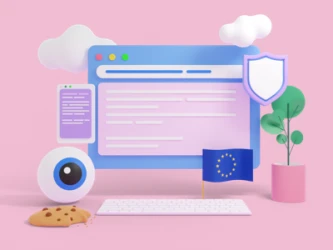While Privacy is at the forefront of modern digital regulation, it’s often difficult to translate this to actionable actions and messages on your website. One primary consideration is your website Cookie Consent Widget and the messaging requirements to meet these regulations and properly inform users. In this article, we’ll go over Cookie Consent requirements and provide some key recommendations to get your messaging right.
What are Cookie Consent Messages?
Cookie Consent Messages are the texts displayed on a website to inform users about the use of cookies and their purposes. It typically appears on consent banners or notices, serving as the first interaction between users and websites regarding data privacy.
Compliance & Legal Implications
Understanding the legal landscape surrounding cookies is vital for compliance. Several key regulations impact cookie usage:
- General Data Protection Regulation (GDPR)
- In compliance with GDPR, website owners must inform users clearly about the use of cookies and provide a detailed list of each type utilized. Additionally, explicit consent from users is required before placing cookies on their browsers, except for strictly necessary cookies. An opt-out mechanism should be enabled, allowing users to withdraw consent easily and document their choices periodically.
- California Consumer Privacy Act (CCPA)
- Under CCPA, website owners must obtain consent for third-party behavioral advertising cookies, treating them as sales of personal information. Consent for analytics cookies is also necessary to mitigate potential non-compliance risks.
- Colorado Privacy Act (CPA)
- CPA mandates website owners to obtain specific, informed, and affirmative consent for processing activities, including targeted advertising and selling personal data.
- Connecticut Data Privacy Act (CTDPA)
- CTDPA requires website owners to provide users with the option to opt out of cookies used for selling personal information. Explicit consent is necessary if collecting sensitive personal information or data from known children.
- Virginia Consumer Data Protection Act (VCDPA)
- VCDPA necessitates website owners to enable users to opt out of the sale of personal information. Consent for the collection and processing of sensitive data must be obtained, adhering to strict legal requirements.
- Additional Considerations
- Beyond GDPR, CCPA, CPA, CTDPA, and VCDPA, website owners should also consider other global privacy laws and regulations when crafting cookie consent messages and obtaining user consent to ensure comprehensive compliance and protection of user data.
Best Practices for Compliance
Whether navigating GDPR, CCPA, or other data privacy laws, adhering to best practices ensures compliance:
- Simplicity is Key: Use clear, straightforward language that is easily understandable for all users.
- Avoid Technical Jargon: Steer clear of complex legal or technical terms that may confuse users.
- Opt-In and Opt-Out Options: Provide conspicuous options for users to accept or reject cookies, with clear explanations of each.
- Transparency is Crucial: Link to the privacy policy or detailed cookie notice for comprehensive information.
- Educate Users: Offer explanations of different cookie categories and their implications, empowering users to make informed choices.
How to Implement Cookie Consent Messaging on Websites
As the need for Cookie Consent Messaging approaches, website owners can take proactive steps:
- Utilizing Consent Management Platforms
Several consent management platforms like GetTerms offer tools for implementing cookie consent messaging effectively. These platforms enable website owners to generate compliant cookie banners and notices, customize text and design, and track user consent preferences.
- Custom Implementation
Alternatively, website owners can manually implement cookie consent messaging by following these steps:
- a. Design the Cookie Banner: Create a visually appealing banner or notice that communicates the use of cookies and provides options for user consent.
- b. Craft Clear Text: Write concise and understandable messages that outline the types of cookies used, their purposes, and user consent options.
- c. Link to Policies: Include links to the privacy policy or detailed cookie notice for users seeking more information.
- d. Test and Optimize: Regularly test the cookie banner for usability and compliance, making adjustments as needed to improve user experience and adherence to regulations.
Clearing Cookies
Clearing Cookies involves several approaches, that would depend on what browser you are using. Provided below are step-by-step guides to different browsers that we simplified to make things easier for you:
Google Chrome:
-
- Click the three dots in the top right corner.
- Go to “More tools” > “Clear browsing data.”
- Check the “Cookies and other site data” box.
- Click “Clear data.”
Mozilla Firefox:
-
- Click the three lines in the top right corner.
- Go to “Settings” > “Privacy & Security.”
- Scroll down to “Cookies and Site Data.”
- Click “Clear Data” and confirm.
Apple Safari:
-
- Select “Preferences” from the top left corner menu.
- Go to the “Privacy” tab.
- Click “Remove All Website Data.”
- Confirm by clicking “Remove Now.”
By following these steps, users can proactively manage their cookies, enhancing privacy and security while navigating the digital landscape.
Frequently-Asked-Questions
- How do cookies track you?
> Cookies utilize unique identifiers to track user activity on websites, enabling personalized experiences and targeted advertising.
- Why do I keep getting cookie messages?
> Laws like GDPR and CCPA mandate websites to inform users about cookies and their options, ensuring transparency and compliance.
- Should you accept cookies?
> Accepting cookies depends on the type and source. Exercise caution if cookies share personal data with third parties or compromise privacy.
- What is the purpose of cookies?
> Cookies serve various purposes, including remembering login credentials, enhancing user experience, and gathering analytics to improve website functionality.
- Should I delete cookies?
> Consider deleting cookies if they collect sensitive information, compromise security, or if you’ve shared private data with the website.
Wrapping Up
Understanding cookie consent messaging and complying with data protection laws are crucial steps. Cookie Consent Messages serve as the first interaction between users and websites, offering transparency about data usage. By navigating legal implications, implementing best practices, and motivating users with informed choices, trust, and user experiences can be improved. With clear messages and proactive management, both website owners and users can move the digital world much more freely and securely.
GetTerms can simplify the complicated task of compliance and allow you to get back to business by addressing multiple items on your compliance checklist, including a cookie policy tailored to your business needs and generating cookie consent banners, we can help. Please take advantage of our services today. Create an account and get started in 5 minutes.

